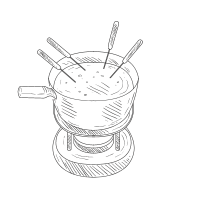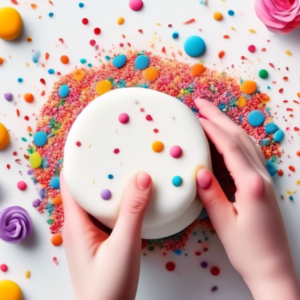Introduction
Fondant, a baker’s secret weapon, is a versatile sugar dough that transforms ordinary cakes into stunning masterpieces. This magical covering, known for its smooth, porcelain-like finish, opens up a world of decorating possibilities, from elegant wedding cakes to whimsical character creations. While store-bought fondant is readily available, nothing compares to the satisfaction and control of crafting your own homemade version.
Advantages of Homemade Fondant
While the convenience of store-bought fondant is undeniable, embarking on a homemade fondant adventure offers a rewarding experience with distinct advantages:
- Taste Customization: Bid farewell to the overly sweet, sometimes bland taste of commercial fondant. Homemade fondant empowers you to tailor the sweetness and flavor profile to your liking. Infuse it with extracts, essences, or liqueurs to complement your cake’s flavor palette.
- Freshness Guaranteed: Homemade fondant guarantees freshness and flavor, unlike store-bought options that may have been sitting on shelves for an indeterminate time. You control the ingredients and the making process, ensuring a delightful taste and texture.
- Cost-Effectiveness: For bakers who frequently don fondant hats, making it at home is significantly more economical, especially when covering large cakes or creating intricate decorations. Simple, budget-friendly ingredients transform into an abundance of fondant.
- Creative Control: Homemade fondant provides unparalleled creative freedom. Experiment with different colors, flavors, and textures to match your cake’s theme flawlessly. Achieve vibrant hues with natural food coloring or experiment with unique flavor combinations for a personalized touch.
Essential Tools and Ingredients
Before embarking on your fondant-making adventure, gather these essential tools and ingredients:
Tools:
- Heavy-Bottom Saucepan: A heavy-bottom saucepan ensures even heat distribution, preventing scorching and ensuring a smooth fondant base.
- Candy Thermometer: Precision is key in candy making, and a candy thermometer guarantees the sugar syrup reaches the correct temperature for optimal fondant consistency.
- Stand Mixer or Hand Mixer: A stand mixer with a dough hook attachment or a powerful hand mixer will be your trusty sidekick in kneading the fondant to its desired smooth and pliable texture.
- Microwave-Safe Bowl: A microwave-safe bowl will be used to melt the marshmallows, forming the base of your fondant.
- Silicone Spatula or Wooden Spoon: Use a heat-resistant silicone spatula or wooden spoon for stirring the hot sugar syrup and incorporating the marshmallow mixture.
- Plastic Wrap: Plastic wrap is essential for wrapping the fondant tightly to prevent it from drying out during storage.
- Powdered Sugar: Prepare a generous amount of powdered sugar for dusting your work surface and kneading into the fondant to achieve the perfect consistency.
Ingredients:
- Mini Marshmallows: Mini marshmallows are the foundation of this recipe, providing the fondant’s elasticity and smooth texture.
- Granulated Sugar: Granulated sugar, combined with water, creates the sugar syrup that binds the marshmallow mixture and gives the fondant its structure.
- Water: Water dissolves the granulated sugar, forming the sugar syrup essential for fondant cohesion.
- Shortening or Butter: Shortening or butter acts as a lubricant, preventing the fondant from sticking to your hands and work surface during kneading and rolling.
- Flavoring Extracts: Add a touch of personality and flavor complexity with extracts like vanilla, almond, or lemon. Choose extracts that harmonize with your cake’s flavor profile.
Step-by-Step Guide to Making Homemade Fondant
With your tools and ingredients prepped, embark on this step-by-step journey to crafting your own homemade fondant:
Step 1: Prepare the Marshmallow Base
- Grease a microwave-safe bowl generously with shortening or butter. This crucial step will prevent the marshmallow mixture from sticking, ensuring easy removal later.
- Empty the bag of mini marshmallows into the greased bowl. Spread them evenly to promote even melting.
- Microwave the marshmallows in 30-second intervals, stirring well after each interval, until they are fully melted and smooth.
Step 2: Create the Sugar Syrup
- In your heavy-bottom saucepan, combine the granulated sugar and water over medium heat. Stir constantly using a silicone spatula or wooden spoon until the sugar dissolves completely.
- Once the sugar dissolves, clip your candy thermometer to the side of the pan, ensuring it doesn’t touch the bottom. Continue to cook the syrup without stirring, allowing it to reach the soft-ball stage, or 235-240°F (113-116°C).
Step 3: Combine and Knead
- Carefully pour the hot sugar syrup into the bowl containing the melted marshmallows. Stir gently at first to combine, being cautious of the hot syrup.
- Gradually incorporate about 2 cups of powdered sugar into the marshmallow mixture. Stir vigorously until the mixture becomes too thick to stir.
- Turn the dough out onto a work surface generously dusted with powdered sugar. Begin kneading the fondant, incorporating more powdered sugar as needed. Knead for about 8-10 minutes, or until the fondant is smooth, elastic, and no longer sticky.
Step 4: Rest and Store
- Shape the kneaded fondant into a smooth ball and lightly coat it with shortening or butter to prevent drying.
- Wrap the fondant tightly in plastic wrap, ensuring no air pockets remain. This step is crucial to prevent the fondant from drying out.
- Allow the fondant to rest at room temperature for at least 2 hours, or preferably overnight, before rolling and using it to decorate your culinary creations.
Troubleshooting Tips for Perfect Fondant
Even with the most meticulous approach, fondant can sometimes throw a curveball. Fear not, for we’ve compiled troubleshooting tips to conquer common fondant woes:
1. Fondant is too Sticky:
If your fondant feels overly sticky, resist the urge to add a mountain of powdered sugar, which can make it dry and crumbly. Instead, knead in small amounts of shortening or butter (a teaspoon at a time) until you achieve a smooth, pliable texture.
2. Fondant is too Dry:
If your fondant feels dry and crumbles easily, it needs moisture. Lightly dampen your hands with water and knead the fondant, incorporating the water gradually. Alternatively, microwave the fondant for 5-10 seconds to warm it slightly, making it more pliable.
3. Fondant is Cracking When Rolling:
Cracks often appear when fondant is rolled too thinly or unevenly. Before rolling, ensure your fondant is at room temperature and knead it thoroughly to warm it up. Roll it out on a smooth, generously powdered sugar-dusted surface, rotating it frequently to maintain an even thickness.
4. Fondant is Sweating or Weeping:
Condensation forming on your fondant, known as sweating or weeping, is often a result of humidity or moisture trapped between the cake and the fondant. To prevent this, ensure your cake is completely cool before applying the fondant. A thin layer of buttercream frosting beneath the fondant acts as a barrier against moisture, preventing those unwanted droplets.
Creative Flavor Variations
Elevate your fondant beyond classic vanilla with these tantalizing flavor variations that will captivate taste buds:
1. Chocolate Indulgence:
Add 1/2 cup of unsweetened cocoa powder along with the powdered sugar during kneading. The cocoa powder infuses the fondant with a rich chocolate flavor that complements chocolate cakes beautifully.
2. Zesty Citrus Burst:
Add the zest of 1 lemon or orange to the melted marshmallow mixture. The zest will infuse the fondant with a refreshing citrus aroma and a subtle tangy flavor, ideal for cakes with fruity profiles.
3. Tropical Coconut Delight:
Stir in 1/2 cup of shredded coconut along with the powdered sugar during kneading. The coconut adds a delightful tropical twist, both in flavor and texture, complementing cakes with coconut or pineapple flavors.
Conclusion
Creating homemade fondant is a culinary adventure that rewards you with taste bud-tantalizing results and endless decorating possibilities. With this comprehensive guide and a sprinkle of patience, you can master the art of fondant making, transforming your cakes into awe-inspiring masterpieces that impress both the eyes and the palate. So, gather your ingredients, don your apron, and unlock a world of fondant creativity – your cakes will thank you for it!

